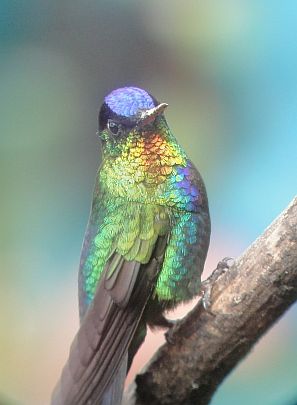Antbirds rule but a lot of them are just terribly difficult to see. Take Immaculate Antbird for example. Go to Tapanti, Virgen del Socorro, or any other forested, middle-elevation site and you will probably hear them each and every morning. Although it’s always nice to hear those tail-wagging, blue-orbitaled skulkers, it’s also a bittersweet sound because you just know that you probably won’t see them without a lot of effort. In the case of Rufous-breasted Antthrush it’s even worse. I can’t tell you the last time I actually saw one of those shy, cloud forest birds in Costa Rica even though I hear them every time I bird Tapanti.
The weird and wonderful nature of antbirds makes the time and effort needed to see them well worth it (it’s not like you have much of a choice anyways). Nevertheless, thank goodness that there are a bunch of other, colorful, cool birds in Costa Rica that can be seen much, much easier. The thin-billed tanagers known as honeycreepers and dacnises are a group of small, beautiful birds that are fairly common, aren’t shy, and are readily seen at a plethora of sites. I so wish that members of the Formicaridae would take a lesson from these little beauties. You have a very good chance at seeing all of them when birding Costa Rica, but here is some information on where to watch them in any case:
Green Honeycreeper: This gorgeous bird is widespread in the neotropical region and easy to see in most humid forested areas of the lowlands and foothills. Although a canopy bird by nature, Green Honeycreepers accommodate birders by coming lower to visit feeders and fruiting bushes. You should see them at any rainforest site in the country as well as hotel gardens near rainforest. They are often found at fruiting trees and frequent mixed flocks. I won’t even list sites for this species because I see them just about every time I visit the humid lowlands and foothills.
The female Green Honeycreeper is plain old green.
The male Green Honeycreeper is a bit more stunning.
Red-legged Honeycreeper: Another common species in many areas, this beautiful little bird frequents lowland gardens, forest, and second growth on the Pacific Slope and the northern part of the Caribbean Slope. It shows up at fruiting trees but is a true aficionado of flowering trees. They make a whiny, nasal call that sounds a lot like that of a gnatcatcher.
Male Red-legged Honeycreeper.
The female is kind of dull…
Shining Honeycreeper: This beautiful bird is most common at humid lowland sites of both slopes. Although it also occurs in foothill rainforests and shows up in gardens, I see them more frequently in lowland rainforest. They can be overlooked because of their small size and penchant for hanging out in the canopy. However, even when seen 100 feet above the ground, the male’s bright yellow legs and female’s streaked underparts stand out. Although they are possible at any number of sites, they seem more common at places like Veragua, Laguna del Lagarto, and Sarapiqui. They also come to the feeders at Talari Lodge!
Male Shining Honeycreeper from Veragua.
Female Shining Honeycreeper at Talari.
Blue Dacnis: This is another one that tends to get overlooked by merit of its size and canopy hangouts. In actuality, this bird is pretty common in lowland rainforests of both slopes. A true species of the lowlands, I don’t think I have even seen it above 300 meters elevation. Keep an eye out for it in fruiting and flowering trees at any lowland, humid forest site.
Male Blue Dacnis from Veragua.
Female Blue Dacnis from Veragua trying to hide behind a flower.
Scarlet-thighed Dacnis: The turquoise blues and velvet black of this little tanager are a sight to behold! Luckily, they are pretty common in a lot of sites. They will move into the lowlands during the dry season but tend to be most frequent at foothill and middle elevation sites (up to about 1,500 meters) on the Caribbean Slope. On the Pacific Slope, they also occur around Monteverde and on the slopes of the Talamancas (think Wilson Botanical Garden and San Gerardo de Rivas). The Scarlet-thighed Dacnis usually shows up at fruiting trees and bushes at the edge of and inside forest. They can show up at any number of sites. Some of the places where I regularly see this beauty are Cinchona, Virgen del Socorro, Quebrada Gonzales, Arenal, El Copal, and Tapanti.
A male Scarlet-thighed Dacnis from El Copal.
A female from Arenal.
I can’t get enough of these species when birding Costa Rica no matter how many times I see them. Visit Costa Rica for birding and you have a pretty good chance of seeing them too!































